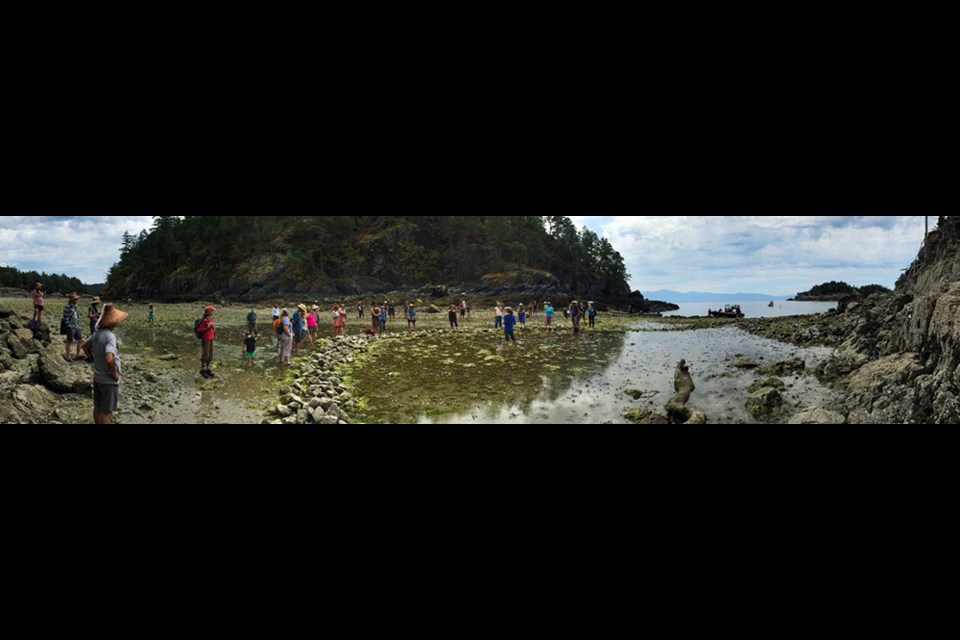On British Columbia’s most remote Gulf Island, an archaeological project is using scientific discovery to further connections between Indigenous and settler communities.
Lasqueti Island, part of qathet Regional District (Area E), is often viewed as “the middle of nowhere.” It’s a 15-kilometre open crossing from Vancouver Island, accessible by passenger ferry only.
But according to island resident Dana Lepofsky, an archaeology professor at Simon Fraser University who leads the Xwe’etay/Lasqueti Archaeology Project (XLAP), pre-colonial Lasqueti was “the island in the middle of everywhere” due to its central position in the Georgia Strait.
“If you see the sea as a highway and not an impediment, it totally changes the way you look at Lasqueti,” said Lepofsky.
The XLAP project, started in 2021, has uncovered evidence of dense Indigenous settlement on the island. Through community outreach events aiming to “honour, respect and protect Indigenous heritage,” the project liaises between settler Lasquetians and Indigenous Nations with historic ties to the island: Qualicum (Qualicum Beach), Tla'amin (qathet), K’ómoks (Courtenay/ Comox), Halalt (Chemainus) and Wei Wai Kum (Campbell River).
Until recently, a misconception held that there had been no permanent Coast Salish population on the island. Many of the original inhabitants of Lasqueti were killed during the 1862 Pacific Northwest smallpox epidemic and survivors moved their permanent settlements away, depopulation which Lepofsky says enabled the idea that the island was “open for the taking” when European settlers arrived in the late 1860s.
But Lepofsky’s research, and oral history from Indigenous communities including Tla’amin Nation, shows this narrative is incorrect. Lepofsky said the oldest site found so far is around 7,000 years old, and there’s “a clear increase in settlements starting about 4,000 years ago, until every little spot is filled.”
Tla’amin elder Betty Wilson said she remembers hearing her own elders discussing Lasqueti and their wish to return there.
“It was a major gathering place, a place where people came together,” said Wilson.
Community outreach is key to XLAP’s mission: “Learning to be respectful of each other’s heritage means knowing each other’s heritage,” said Lepofsky.
XLAP-organized community events bring together settler Lasquetians and neighbouring First Nations. While it’s now standard for archaeologists to collaborate with First Nations when working on their territories, Lepofsky said as far as she knows, XLAP is one of the only projects spearheading collaboration between Indigenous and non-Indigenous neighbours.
Wilson, who has attended two community events, said that being on the island is “such a good feeling of déjà vu, or coming home […]. It’s really such a good feeling when I visit a territory that our people occupied.”
In a May 2023 community event, Qualicum Nation hosted a burning ceremony on the island to honour ancestors who lived and died on Lasqueti. Wilson, who attended the ceremony, says she appreciated the contributions of settler Lasquetians. “Everyone followed protocol, were respectful,” she said. “That’s important because when we’re there, our ancestors are there with us.”
XLAP’s archaeology focuses mostly on landscape architecture such as village sites, shell deposits (used in house foundations), clam gardens and fish traps. Artefacts have been traced to origins as far away as Idaho, indicating the cosmopolitan nature of pre-colonial Lasqueti.
Lasqueti today is mostly private property, adding extra challenges to recording and studying historic settlements. Policy gaps mean landowners may be uncertain about what an archaeological site means for their property and, therefore, are sometimes reluctant to work with research teams.
Sheila Ray, a Lasquetian since 1974 and the island cemetery caretaker, says there is a minority of islanders who “don’t like what [Lepofsky] is doing,” and are “entrenched in their beliefs” that Indigenous people never lived here.
During summer 2023, XLAP conducted a high-precision survey of the cemetery, which has been translated into a map and mural. Preserving the island’s settler past, as well as Indigenous history, is a way to “bridge that gap for people that are fearful of archaeology,” said Ray.
Wilson hopes to see the shared history and relationship between Indigenous Nations and settler Lasquetians continue. She said she’s an “eternal optimist” that the connection between the communities will grow, through “work on both sides.”
Going forward, Lepofsky and her team are creating a website, Layered History, a digital atlas for the project’s findings. Plans are also underway for public artwork and signage that will include Coast Salish languages.
“The archaeology is cool,” said Lepofsky, “but it’s a bigger thing about Indigenous heritage and countering erasure and countering fear, and that happens when you bring people together.”
Cara Gordon is a journalism and humanities student at Carleton University in Ottawa.



